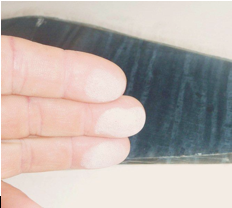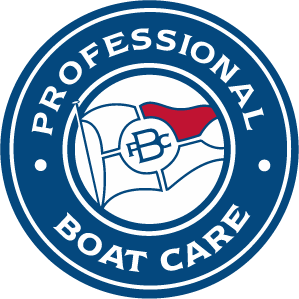I once heard a boat broker talking about ‘lucky’ and ‘unlucky’ boats. He was referring to the contrasting ways different owners maintain their boats. I spend most days in and about various marinas and can report that sadly, and I think unnecessarily, there are more unlucky boats than lucky ones. Neglecting the maintenance of your boat has obvious aesthetic consequences but it also seriously undermines her resale value. The owners of ‘lucky’ boats have long understood that routine preventative maintenance, such as monthly wash downs and regular polishing, is the most cost effective solution to maintaining their boat year round. This series of articles will touch on the basics of boat care.
Start with a clean slate!

Chalky finger tips indicate gelcoat oxidization. If you have a lucky boat well, keep at it, but if your boat is a bit down on its luck, it is not too late. My advice is start with a clean slate. That requires getting your gelcoat or paint in good condition. If it has lost its gloss and started to oxidize (white chalk on your finger tips), it requires a cut and polish.
You can do this yourself but to the untrained, cutting and polishing is a difficult, labour intensive job. Setting up with the right tools and products is expensive and to obtain an even, flawless finish without swirl marks, takes a lot of practice. Additionally, if the boat has yellowing stains and rust marks, they will need to be treated with an acid based wash. If used incorrectly these products can do more harm than good. My advice is leave the cut and polish process to the professionals.
Once the surface has been restored, it will need to be sealed and regularly maintained with a surface polish which will act as a sunscreen and help repel grime and salt from entering the gelcoat pours. This sort of upkeep is well within the skill range of any dedicated owner.

Cover up
Naturally good covers are the best protection. But not all boats have them and even the best covers leave some surfaces exposed. I find surfaces exposed to sun require a top up hand polish every three months or so in order to maintain a protective barrier against the UV rays which cause oxidization. Flat surfaces such as cabin tops, fronts of flybridges and toe rails are particularly vulnerable. Regular hand polishing also helps when washing off sooty streak marks that will develop. Remember though, if you don’t keep the polishing regime up, the oxidization will quickly start again – it is not a once off solution – there are no once off solutions.
Take some advice though – with such a huge range of polishes available and with some making big claims as to their effective life span, choosing the right one can be confusing. To add to this, some polishes seem to work better on different gelcoats than others! My advice is talk to someone before you start.
Keeping her clean
A quality brush and the right detergents are vital. After each trip you should wash the salt off all surfaces. Start from the highest point of your boat and work your way down and aft, ensuring you hose under awnings and pay particular attention to the stainless steel and areas where salt spray has or will, build up.

Fresh water is all that is needed for this and if the boat is kept well polished, most dirt and salt will hose off without the need for rubbing or brushing.Even if you are using the boat regularly, I would recommend a monthly wash with a gentle detergent to remove the grime and sooty streaks that form on the cabin sides, hull and even the clears. Keeping on top of these marks will help prevent them staining the gelcoat or the clears and so delay the need for the next cut and polish.
Choosing the right detergent is important. Avoid the heavy duty detergents like ‘truck wash’ or dish washing detergents. They will remove the protective polish and speed up the oxidization process. Another trap for the unwary is the use of acid base cleaners. These are readily available in chandleries and are commonly used to remove yellow water, or rust stains from gelcoat. The trouble is acid based cleaners strip everything out of gelcoat. I think they are best used only prior to a cut and polish job.
If the boat is polished regularly, a gentle biodegradable ‘wash and wax’ type detergent with a soft head brush is all that is required. To avoid water spot marks, chamois the boat, windows and stainless steel before they dry.

Suggested routine exterior maintenance
Set yourself a monthly job list which should include the following as an absolute minimum;
- After every trip rinse the boat with fresh water to remove salt and dust, then chamois dry
- Each month wash all exterior surfaces with a gentle detergent and chamois dry. Do the same for the windows and stainless steel and polish the exterior of all clears with a dedicated clears product which are available from chandleries.
- Every third month hand polish all surfaces exposed to sun.
- Spot polish stainless steel when surface rust appears with a dedicated metal polish from chandleries.
In coming editions we will cover topics such as looking after your clears, teak deck maintenance, rust and mould removal as well as interior maintenance. Until then, happy and safe boating.
